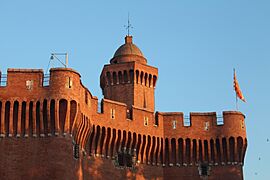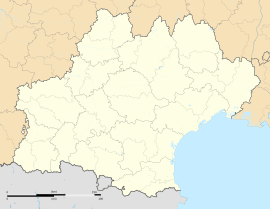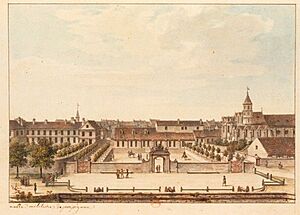Perpignan facts for kids
Quick facts for kids
Perpignan
Perpinyà (Catalan)
|
||
|---|---|---|
|
Prefecture and commune
|
||
|
||
| Country | France | |
| Region | Occitanie | |
| Department | Pyrénées-Orientales | |
| Arrondissement | Perpignan | |
| Canton | Perpignan-1, 2, 3, 4, 5 and 6 | |
| Intercommunality | Perpignan Méditerranée Métropole | |
| Area
1
|
68.07 km2 (26.28 sq mi) | |
| Population
(2021)
|
119,656 | |
| • Density | 1,757.84/km2 (4,552.8/sq mi) | |
| Demonym(s) | Perpignanais (masc.), Perpignanaise (fem.) (French) perpinyanès (masc.), perpinyanesa (fem.) (Catalan) |
|
| Time zone | UTC+01:00 (CET) | |
| • Summer (DST) | UTC+02:00 (CEST) | |
| INSEE/Postal code |
66136 /66000
|
|
| Elevation | 8–95 m (26–312 ft) (avg. 30 m or 98 ft) |
|
| Website | Mairie-Perpignan.fr | |
| 1 French Land Register data, which excludes lakes, ponds, glaciers > 1 km2 (0.386 sq mi or 247 acres) and river estuaries. | ||
Perpignan is a lively city in Southern France. It's the main city of the Pyrénées-Orientales area. You'll find it in the middle of the Roussillon plain, close to the Pyrenees mountains and the beautiful Mediterranean Sea.
In 2021, about 119,656 people lived in Perpignan. If you count the surrounding areas, the total population was over 205,000. This makes it the last big French city before you reach the border with Spain. Some people even call Perpignan the "entrance" to the Iberian Peninsula.
Perpignan used to be the capital of the old region called County of Roussillon. It was also the main city on the mainland for the Kingdom of Majorca in the 1200s and 1300s. The city still has a large old town with colorful houses and narrow streets. These streets stretch between the Têt River and its smaller branch, the Basse.
The city is also famous for its International Festival of Photojournalism. It also hosts the medieval Trobades festival. Plus, it's known for its very old garnet jewelry making.
Contents
- Exploring Perpignan: Location & Climate
- What Does the Name "Perpignan" Mean?
- A Look Back in Time: Perpignan's History
- Learning in Perpignan
- How Many People Live Here?
- Fun and Culture in Perpignan
- Sports in Perpignan
- What Does Perpignan Make?
- Cool Places to See
- Famous Faces from Perpignan
- Gallery
- See also
Exploring Perpignan: Location & Climate
Where is Perpignan Located?
Perpignan is right in the center of the Roussillon plain. It's about 13 kilometers (8 miles) west of the Mediterranean coast. This makes it the southernmost city in mainland France.
-
Perpignan's location within the Pyrénées-Orientales area.
Rivers and Waterways
The city has two rivers running through it. The biggest is the Têt River. The Basse is a smaller river that flows into the Têt. Sometimes, these rivers can flood. For example, in 1892, the Têt River flooded Perpignan. It destroyed 39 homes and left many families without a place to live.
What's the Weather Like?
Perpignan has a typical Mediterranean climate. This means it has hot summers and mild winters. You might think it doesn't rain much, but the city actually gets a similar amount of rain as the rest of France. However, the rain often comes in short, heavy bursts. It might rain for a few hours, and then there won't be any rain for weeks!
Summers are very hot, sometimes reaching 40 °C (104 °F). It rarely snows in winter. A cool, strong wind called the Tramontana often blows from the northwest. This wind helps keep the sky clear and sunny. But it also makes winters feel colder than you might expect for a city so far south.
| Climate data for Perpignan (1991–2020 normals), extremes since 1924 | |||||||||||||
|---|---|---|---|---|---|---|---|---|---|---|---|---|---|
| Month | Jan | Feb | Mar | Apr | May | Jun | Jul | Aug | Sep | Oct | Nov | Dec | Year |
| Record high °C (°F) | 25.0 (77.0) |
26.5 (79.7) |
28.0 (82.4) |
32.4 (90.3) |
34.4 (93.9) |
42.4 (108.3) |
40.5 (104.9) |
39.9 (103.8) |
36.8 (98.2) |
34.2 (93.6) |
28.1 (82.6) |
26.7 (80.1) |
42.4 (108.3) |
| Mean daily maximum °C (°F) | 12.7 (54.9) |
13.4 (56.1) |
16.4 (61.5) |
18.7 (65.7) |
22.3 (72.1) |
26.8 (80.2) |
29.5 (85.1) |
29.4 (84.9) |
25.6 (78.1) |
21.2 (70.2) |
16.3 (61.3) |
13.3 (55.9) |
20.5 (68.8) |
| Daily mean °C (°F) | 8.7 (47.7) |
9.2 (48.6) |
12.0 (53.6) |
14.2 (57.6) |
17.8 (64.0) |
22.0 (71.6) |
24.6 (76.3) |
24.5 (76.1) |
20.9 (69.6) |
17.0 (62.6) |
12.3 (54.1) |
9.3 (48.7) |
16.0 (60.9) |
| Mean daily minimum °C (°F) | 4.8 (40.6) |
5.0 (41.0) |
7.6 (45.7) |
9.7 (49.5) |
13.3 (55.9) |
17.2 (63.0) |
19.7 (67.5) |
19.7 (67.5) |
16.1 (61.0) |
12.9 (55.2) |
8.4 (47.1) |
5.3 (41.5) |
11.6 (53.0) |
| Record low °C (°F) | −8.2 (17.2) |
−11.0 (12.2) |
−5.9 (21.4) |
0.2 (32.4) |
2.4 (36.3) |
7.4 (45.3) |
11.2 (52.2) |
10.4 (50.7) |
5.0 (41.0) |
1.2 (34.2) |
−5.7 (21.7) |
−6.3 (20.7) |
−11.0 (12.2) |
| Average precipitation mm (inches) | 60.1 (2.37) |
40.9 (1.61) |
51.6 (2.03) |
66.1 (2.60) |
45.6 (1.80) |
23.6 (0.93) |
15.1 (0.59) |
22.7 (0.89) |
43.0 (1.69) |
82.1 (3.23) |
72.6 (2.86) |
54.9 (2.16) |
578.3 (22.76) |
| Average precipitation days (≥ 1 mm) | 5.0 | 3.8 | 4.9 | 6.2 | 5.7 | 3.8 | 2.6 | 3.1 | 4.4 | 5.0 | 4.9 | 4.7 | 54.1 |
| Average relative humidity (%) | 70 | 68 | 64 | 64 | 66 | 62 | 59 | 63 | 68 | 73 | 71 | 71 | 67 |
| Mean monthly sunshine hours | 141 | 164 | 207 | 220 | 241 | 268 | 300 | 273 | 224 | 175 | 147 | 131 | 2,491 |
| Source 1: Météo France | |||||||||||||
| Source 2: Infoclimat.fr (humidity, 1961–1990) | |||||||||||||
Getting Around Perpignan
Roads
The A9 motorway is a major road that connects Perpignan to big cities like Barcelona in Spain and Montpellier in France.
Trains
Perpignan has a main train station called Gare de Perpignan. From here, you can catch trains to Paris, Barcelona, Toulouse, and other nearby places. The famous artist Salvador Dalí once said this station was the "Cosmic Centre of the Universe"! He had a special vision there in 1963.
Airport
If you want to fly, the closest airport is Perpignan–Rivesaltes Airport.
What Does the Name "Perpignan" Mean?
The name Perpignan first appeared in old writings around the year 927. It was called Perpinianum back then. Later, it was known as Villa Perpiniano and Pirpinianum. The name probably comes from an old Roman name, Perpennius.
A Look Back in Time: Perpignan's History
 County of Roussillon 927–1172
County of Roussillon 927–1172 Principality of Catalonia (
Principality of Catalonia ( Crown of Aragon) 1172–1276
Crown of Aragon) 1172–1276

 Kingdom of Majorca 1276–1344
Kingdom of Majorca 1276–1344 Principality of Catalonia (
Principality of Catalonia ( Crown of Aragon) 1344–1463
Crown of Aragon) 1344–1463 Kingdom of France 1463–1493
Kingdom of France 1463–1493 Principality of Catalonia (
Principality of Catalonia ( Crown of Aragon,
Crown of Aragon,  Spanish Empire) 1493–1659
Spanish Empire) 1493–1659

 Kingdom of France 1659–1792
Kingdom of France 1659–1792

 French Republic 1792–1804
French Republic 1792–1804 French Empire 1804–1815
French Empire 1804–1815

 Kingdom of France 1815–1848
Kingdom of France 1815–1848 French Republic 1848–1852
French Republic 1848–1852 French Empire 1852–1870
French Empire 1852–1870 French Republic 1870–1940
French Republic 1870–1940 French State 1940–1944
French State 1940–1944 French Republic 1944–present
French Republic 1944–present
People lived in this area even during Roman times. But the city of Perpignan as we know it started around the early 900s. Soon after, it became the capital for the counts of Roussillon.
In 1172, Count Girard II gave his lands to the Counts of Barcelona. Perpignan gained some self-governing rights in 1197, meaning its citizens had more say in how the city was run. In 1258, the French king Louis IX gave up his claims over Roussillon in a treaty.
The Golden Age of Perpignan
In 1276, James I the Conqueror created the Kingdom of Majorca. Perpignan became the capital of the parts of this new kingdom that were on the mainland. The next few decades were a "golden age" for the city. It became rich from making cloth, leather goods, and fancy jewelry. In 1285, King Philippe III of France died here while returning from a war.
In 1344, Peter IV of Aragon took over the Kingdom of Majorca. Perpignan became part of the Principality of Catalonia again. A few years later, a terrible illness called the Black Death caused about half of the city's population to die.
Changes in Rule
In 1463, the French king Louis XI of France attacked and took over Perpignan. There was a big uprising against French rule in 1473. It was put down harshly after a long siege. But in 1493, Charles VIII of France gave Perpignan back to Ferdinand II of Aragon. He wanted to make peace with Spain so he could invade Italy.
During the Thirty Years' War, the French attacked and captured Perpignan again in 1642. Seventeen years later, in 1659, Spain officially gave Perpignan to France in the Treaty of the Pyrenees. Since then, it has remained a French city.
In June 2020, Louis Aliot was elected as the mayor of Perpignan.
Learning in Perpignan
Perpignan has many schools for young people. More than 10,000 students from ages 2 to 12 go to 61 preschools and primary schools. The city also has 26 high schools for older students.
How Many People Live Here?
| Historical population | |||||||||||||||||||||||||||||||||||||||||||||||||||||||||||||||||||||||||||||||||||||||||||||||||||||||||||||||||||
|---|---|---|---|---|---|---|---|---|---|---|---|---|---|---|---|---|---|---|---|---|---|---|---|---|---|---|---|---|---|---|---|---|---|---|---|---|---|---|---|---|---|---|---|---|---|---|---|---|---|---|---|---|---|---|---|---|---|---|---|---|---|---|---|---|---|---|---|---|---|---|---|---|---|---|---|---|---|---|---|---|---|---|---|---|---|---|---|---|---|---|---|---|---|---|---|---|---|---|---|---|---|---|---|---|---|---|---|---|---|---|---|---|---|---|---|
|
|
||||||||||||||||||||||||||||||||||||||||||||||||||||||||||||||||||||||||||||||||||||||||||||||||||||||||||||||||||
| Source: EHESS and INSEE (1968-2017) | |||||||||||||||||||||||||||||||||||||||||||||||||||||||||||||||||||||||||||||||||||||||||||||||||||||||||||||||||||
Fun and Culture in Perpignan
Since 2004, Perpignan has hosted a free three-day music festival called Guitares au Palais. It happens every August at the Palace of the Kings of Majorca. The festival features many types of guitar music, from pop to traditional acoustic. Famous musicians from around the world have played there.
Every September, Perpignan also holds the famous Visa pour l'Image festival. This event celebrates photojournalism, which is telling stories through pictures. You can see amazing photo exhibitions in old buildings around the city.
In 2008, Perpignan was named the Capital of Catalan Culture. Because of this, many street signs in the city are written in both French and Catalan.
Sports in Perpignan
Just like other parts of southern France, Perpignan loves rugby! The city has a rugby union team called USA Perpignan. They often play in big European competitions. They have also won the French Top 14 championship seven times, most recently in 2009. They play their games at the Stade Aimé Giral.
Perpignan also has a rugby league team called Catalans Dragons. This team plays in the British Super League. Many British rugby fans visit Perpignan to watch the Dragons play against teams from northern England. The Catalans Dragons made history in 2018. They were the first non-English team to win the Challenge Cup! They play at the Stade Gilbert Brutus.
Perpignan also has a local association football (soccer) team, Canet Roussillon FC. There's even an Australian rules football club, the Perpignan Tigers, and an American football club, the Grizzlys Catalans.
From 1946 to 1949, Perpignan hosted the Roussillon Grand Prix. This was a big Grand Prix motor racing event held on the city's streets.
What Does Perpignan Make?
In the past, Perpignan was known for trading wine, olive oil, and corks. Corks come from cork oak trees, which grow well in Perpignan's mild climate. The city also traded wool, leather, and iron. Today, JOB rolling papers are made in Perpignan.
Cool Places to See
Perpignan Cathedral
Construction on the Perpignan Cathedral started in 1324 and finished in 1509. It's a very old and impressive building.
Palace of the Kings of Majorca
The Palace of the Kings of Majorca was built in the 1200s. It sits on a high hill and is surrounded by strong walls. These walls were made even stronger by famous military engineers like Vauban in the 1600s.
The Castillet
The old walls around the city were taken down in 1904 to make way for new buildings. But the main city gate, called the Castillet, was saved. It's a small fortress built in the 1300s. It was even used as a prison until the late 1800s!
Hôtel Pams
The Hôtel Pams is a beautifully decorated mansion. It was built for a wealthy person named Jules Pams. It shows what rich people's homes looked like in the early 1900s.
Les Halles de Vauban
Les Halles de Vauban are new indoor markets that opened in 2017. They are located along the city's canal. Here, you can buy fresh fruits, vegetables, bread, flowers, and cheese. There's also a food court where you can enjoy different kinds of meals.
Famous Faces from Perpignan
Many interesting people are linked to Perpignan:
- Paul Alday (c.1763–1835), a violinist and composer.
- Christian Andreu (born 1976), a guitarist.
- François Arago (1786–1853), a scientist and politician.
- Aristide Maillol (1861–1944), a famous sculptor and painter.
- Hyacinthe Rigaud (1659–1743), a well-known painter.
Salvador Dalí and the "Center of the Universe"
The famous Catalan surrealist artist Salvador Dalí visited Perpignan in 1963. He declared that the city's train station was the "centre of the Universe"! He said he always had his best ideas while sitting in its waiting room. Dalí even painted a picture called La Gare de Perpignan to remember this special vision.
Years later, he also claimed that the Iberian Peninsula rotated exactly at Perpignan station millions of years ago. Today, above the station, there's a monument honoring Dalí. On one of the main platforms, you can see the words «perpignan centre du monde» (which means "perpignan centre of the world") painted in large letters.
Gallery
See also
 In Spanish: Perpiñán para niños
In Spanish: Perpiñán para niños





























